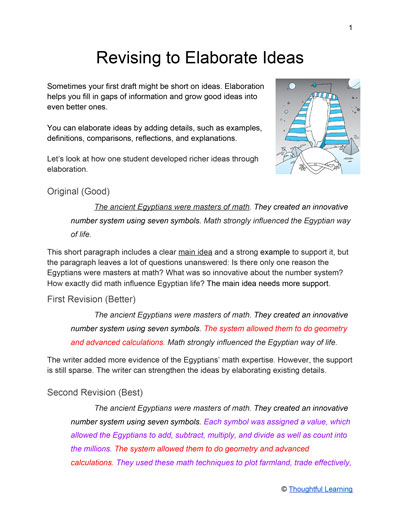
Author Shannon Hale describes her writing process as “shoveling sand into a box so that later I can build castles.” Hale's metaphor speaks to the power of revising.
How to revise, though, remains a mystery to many student writers. They tend to write one draft, correct a few surface errors, and submit their work without contemplating deeper improvements. As a result, potential castles never take shape.
You can demystify revising by giving your students time, support, and practice with concrete revision strategies.
Featured Activity: Revising to Elaborate Ideas
Provide this lesson to your students to help them learn about elaboration, see it in action, and apply it to their own writing.
Download the PDF or copy the Google Doc.
Teacher Support
Consider this support as you implement the lesson.
Level
Grades 4-8
Learning Objectives
By completing this activity, students will . . .
- Apply an effective revising strategy to their writing.
- Use supporting details to clarify and complete writing ideas.
- Read critically for incomplete ideas.
- Respond to a peer's writing.
Teaching Tips
- Remind students that writers of all skill levels need to revise. Share these quotations from successful authors to drive home the point:
- "I'm not a very good writer, but I'm an excellent rewriter." —James Michener
- "Good writing is essentially rewriting." —Roald Dahl
- "I'm a rewriter. That's the part I like best . . . once I have a pile of paper to work with, it's like having the pieces of a puzzle. I just have to put the pieces together to make a picture." —Judy Blume
- Reiterate that students should revise before they edit.
- Clarify that revising involves evaluating the big picture, reviewing the ideas, organization, and voice—and later word choice and sentence fluency. Editing involves checking the revised writing for spelling, punctuation, and other conventions of writing.
- Before students work on the activity, display a sample of your own writing. Ask students to help you elaborate the ideas, modeling the steps in the activity.
- Recommend students use a different color text for the revisions they make during the activity. That way they—and you—can visualize their progress.
